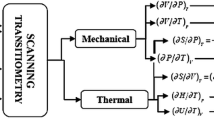Abstract
Scanning transitiometry is a newly developed technique in which one of the independent variables (p,V, or T) is scanned in the working cell of a very sensitive calorimeter while the other independent variable is kept constant. The change of the dependent variable is recorded simultaneously with the thermal effect associated with the process or the system under investigation. In the case of non-reacting systems which remain in a homogeneous state, both the mechanical and thermal outputs thus obtained give straightforward access to pairs of thermomechanical coefficients: α p and κ T , β V and κ T , C p and α p , C V and β V , depending on the pair of selected independent variables. When the system or the material sample goes through a chemical reaction or a phase change, the recorded information yields the corresponding heat and pVT characteristics. The working cell may also house an optical fiber probe for spectrophotometric in situ readings from UV to NIR, as well as injection and stirring devices permitting investigation of reacting systems. The actual operating ranges of current scanning transitiometers are 173 K<T<673 K and 0.1<p<200 MPa (or 400 MPa). With such equipment, bulk properties, phase transitions, and reactions (i.e., polymerization) can be advantageously studied. Selected examples, all dealing with polymeric systems (including biopolymers), are illustrated, namely, measurements of thermomechanical coefficients (thermal expansion, compressibility), characterization of transitions (fusion, crystallization, glass transition, gelatinization) and particle synthesis. All examples show that scanning transitiometry is a versatile technique that can be used to fully characterize thermophysical properties as well as the thermodynamic behavior of a large variety of systems and materials.
Similar content being viewed by others
REFERENCES
L. H. Sperling, Introduction to Physical Polymer Science, 3rd edn. (Wiley, New York, 2001), p. xxix.
S. L. Randzio, Thermochim. Acta 355:107(2000).
P. Rollet and R. Bouaziz, L'analyse thermique, Tome 1: Les changements de phase (Gautier-Villars, Paris, 1972), p. 3577.
G. W. H. HÖhne, Thermochim. Acta 332:115(1999).
Z. Zhang and Y. P. Handa, Macromolecules 30:8505(1997).
S. L. Randzio, J. Therm. Anal. Cal. 57:165(1999).
S. L. Randzio, J.-P. E. Grolier, and J. R. Quint, High Temp.-High Press. 30:645(1998).
P. Pruzan, L. TerMinassian, and A. Soulard, High-Pressure Science and Technology 1:368(1979).
S. L. Randzio, J.-P. E. Grolier, and J. Quint, Rev. Sci. Instrum. 65:960(1994).
Rodier-Renaud, S. L. Randzio, J.-P. E. Grolier, and J. R. Quint, J. Polym. Sci. Part B: Polym. Phys. 34:1229(1996).
S. L. Randzio, Pure Appl. Chem. 63:1409(1991).
P. Ehrenfest, Proc. Kon. Akad. Wetensch. 36:153(1933).
S. L. Randzio, Chem. Soc. Rev. 25:383(1996).
S. L. Randzio, Thermochim. Acta 300:29(1997).
S. L. Randzio, J. Therm. Anal. 48:573(1997).
S. L. Randzio and J.-P. E. Grolier, Anal. Chem. 70:2327(1998).
M. Loro, J. S. Lim, and M. A. McHugh, J. Phys. Chem. B 103:2818(1999).
S. L. Randzio, Ch. Stachowiak, and J.-P. E. Grolier, J. Chem. Thermodyn. 35:639(2003).
P. Rubens, J. Snauwaert, K. Heremans, and R. Stute, Carbohydtrate Polym. 39:231(1999).
P. Rubens and K. Heremans, Biopolymers 54:524(2000).
G. Weber and H. D. Drickamer, Q. Rev. Biophys. 16:89(1983).
S. L. Randzio, I. Flis-Kabulska, and J.-P. E. Grolier, Macromolecules 35:8852(2002).
M. Shen, W. N. Hansen, and P. C. Romo, J. Chem. Phys. 51:425(1969).
D. J. Pastine, J. Appl. Phys. 41:5085(1970).
D. J. Pastine, J. Chem. Phys. 49:3012(1968).
F. Dan and C. Vasiliu-Oprea, Colloid Polym. Sci. 276:483(1998).
H. Sekiguchi, in Ring-Opening Polymerization, Vol. 2, K. J. Iving and T. Saegusa, eds. (Elsevier, London, 1984), p. 833.
J. Stehlicek and J. Sebenda, Eur. Polym. J. 22:769(1986).
F. Dan and J.-P. E. Grolier, Setaram News 7:i3-i4 (2002).
S. L. Randzio, Thermochim. Acta 398:75(2003).
Author information
Authors and Affiliations
Corresponding author
Rights and permissions
About this article
Cite this article
Grolier, JP.E., Dan, F., Boyer, S.A.E. et al. The Use of Scanning Transitiometry to Investigate Thermodynamic Properties of Polymeric Systems over Extended T and p Ranges. International Journal of Thermophysics 25, 297–319 (2004). https://doi.org/10.1023/B:IJOT.0000028469.17288.de
Issue Date:
DOI: https://doi.org/10.1023/B:IJOT.0000028469.17288.de



